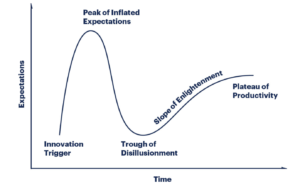
Gartner Gets Hyped for Emerging Tech

It’s the dog days of August, which means it’s time for Gartner to issue its annual Hype Cycle for Emerging Technologies. Data and AI are featured prominently in this year’s Hype Cycle, which is the first one to be published during a viral pandemic.
COVID-19 certainly presents an interesting backdrop for technology this year. Gartner notes a meteoric rise of health passports, or applications that government authorities use to determine whether a citizen is allowed to visit certain places or access certain services.
“The sheer populations in India and China using health passports pushed this technology to a 5% to 20% market penetration, an unprecedented number for a technology just entering the Hype Cycle,” Gartner contributor Kasey Panetta wrote in a blog post published today.
Health passports is already well on its way toward the Peak of Inflated Expectations despite being less than six months old. But Gartner sees other substantive trends emerging from the technological tea leaves, starting with the composite architectures, which is Gartner’s top trend.
A composite architecture is a flexible system that allows enterprises to rapidly adapt their systems and applications when conditions change. Built on data fabrics and often incorporating embedded AI and 5G, composite architectures allow companies to “recompose” as needed, such as during a pandemic or a recession, Gartner says.
Gartner identifies modularity, efficiency, continuous improvement, and adaptive innovation as the four core principles of a composite architecture. Enterprises often obtain these IT characteristics in a piecemeal fashion, but Gartner sees composable architectures emerging to provide them across the whole organization in a more deliberate manner.
Data fabrics moved solidly up the hype curve and is now nearing peak hype. Embedded AI, a new technology for the 2020 Hype Curve for Emerging Technologies, debuted right next to data fabrics. The composable enterprise also debuted a little further down the hype curve (possibly replacing the decentralized autonomous organization, which appeared in last year’s Hype Cycle for Emerging Technologies). Composite AI also made its first appearance on the list.
Another hot trend identified by Gartner is algorithmic trust. The rash of fake news and data leaks has eroded the trust that consumers place in central authorities, such as governments and clearinghouses for news or data. Taking the place of central authorities are algorithms, which increasingly make decisions impacting peoples’ lives, Gartner says.
Part and parcel of algorithmic trust are data models that value the privacy and security of data, the provenance of assets, and the identities of people and things, Gartner says. Explainable AI is a core element of algorithmic trust, as are responsible AI and differential privacy. Blockchain also plays heavily here.
Explainable AI has gotten over the hype hump (i.e. the Peak of Inflated Expectations) and is on its way into the Trough of Disillusionment. Differential privacy is a new addition to the curve (although a similar category, synthetic data, appeared on last year’s Hype Cycle for Emerging Technologies).
We’re also seeing the emergence of non-silicon-based storage and processing technologies, such as computers based on DNA, as well as biodegradable sensors and carbon-based transistors. These technologies, which Gartner identified as its third big trend, are helping the IT world move forward as we near the end of Moore’s Law.
Formative AI, or AI that can dynamically change to respond to a situation, is Gartner’s fourth big trend. Generative AI, or AI that generates content, is one example of a formative AI. It can be used for creating deep fakes on the Internet (which is bad) as well as helping with drug discovery (which is good).
Composite AI (new to the Hype Cycle for Emerging Technologies this year) is one of the technologies that’s related to Formative AI, as well as differential privacy, small data (not on the list), and self-supervising learning (new to the list).
“Digital Me” is the fifth trend. The health passport mentioned earlier is an example of emerging technologies are impacting people directly, as well as technologies like digital twins (new to the Hype Cycle for Emerging Technologies), and brain-machine interfaces (new).
All told, there was a lot of churn on this year’s Hype Cycle for Emerging Technologies. Twenty-two out of 30 items on last year’s list failed to make it to the 2020 list. That’s not counting 5G, which appeared to turn into private 5G for the 2020 list, or knowledge graphs and graph analytics, which appeared to turn into ontologies and graphs for 2020. Smart dust has not made the list for several years.
Gartner will present its 2020 2020 Emerging Technologies Hype Cycle during a live webinar on September at 7 a.m. PT. You can register for it here.
Related Items:
Gartner Sees AI Democratized in Latest ‘Hype Cycle’
How AI Fares in Gartner’s Latest Hype Cycle




























